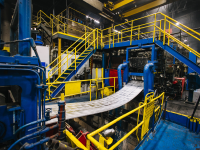We are already halfway through the current financial year and the slowdown in the commodity market is showing no signs of letting up. Key “leading indicators” like aluminium have been declining steadily on the London Metal Exchange (LME), hitting fresh lows every day. This trend is clearly indicative of a widespread economic downturn which has already hit China, and unlike the recent crisis in Greece, this is likely to have a rather prominent impact on major economies of the world.
So, let us take a micro-view of the aluminium market and try to sum up (taking cues from industry analysts) the factors underlying this continuous slump, how they are affecting global aluminium producers and what they can do to tide over this situation sustaining minimal losses, or by spreading the risks as much as possible.
Price fall on the back of aluminium oversupply
Demand-supply mismatch, though responsible for price fluctuation, does not really explain fully the current phenomenon of LME aluminium fall. Demand for the silvery white metal has been growing at a moderate rate since 2011-2012 with automobile and construction sectors contributing as major demand drivers. Supply on the other side has always outpaced demand, thanks to the obsession of the global metal producers on production capacity expansion year on year. However, the gap has been narrowing lately in the wake of various industry developments.
So, what exactly led to the aluminium glut?
China accounts for half of the world’s aluminium supply. It has been churning out record amounts of the metal, which is shipped out mostly in the form of semi-fabricated products. A significant quantity of primary metal also leaves China. Cumulative export of this unwrought aluminium and products swelled 35 per cent in the first half from a year earlier to 2.5 million tons.
The UAE too is selling large amounts of the metal overseas below cost of production by virtue of the economies of scale they have achieved in the recent past due to availability of cheap power.
Unabated exports from these two regions are compounding the aluminium oversupply, pulling prices down at an alarming rate.
What are the consequences?
Consequences are clearly discouraging and far fetched.
- Premiums on immediate deliveries are getting reduced, thereby hurting companies’ net earnings
- China’s export of aluminium produced under Govt. induced subsidies is unfair competition to producers in the overseas market. So long, a strong dollar has helped them (except in US) to withstand the Chinese onslaught, but with the price trends showing no signs of correction that may soon become impossible.
- Cheap imports are eating into domestic market shares of aluminium producers forcing them to revisit their production plans.
- Ramp-up plans are getting stalled.
- Global conglomerates like Vedanta Resources are considering restructuring of their high-cost operations in aluminium segments.
- Overhead costs are rising due to idle capacities.
- Job cuts are becoming inevitable.
Solution:
A serious attempt to curb Chinese output followed by planned smelting operations or at least capping of some kind can only check the aluminium oversupply and the resultant price fall on an immediate basis. But Chinese smelters seem to be totally oblivious to the fact as they continue to produce the metal in their newly opened cost-efficient smelters.
Production cutbacks if any will likely come from the US producers and some from the Russian producers as well, but that will not be sufficient for preventing the prices from falling further.
Survival strategies:
Following are some of the knee jerk reactions that we saw recently coming from aluminium producers from across the world. These are basically survival strategies that they are banking on right now, though with long-term implications.
- Seeking government support: Aluminium Association of India (AAI) recently took the plea of the aluminium producers in the country to hike import duty on the metal by 10 per cent to Indian Ministry of Mines. To that, the Ministry has agreed to double the import tax which is expected to ease the situation a bit in the domestic market.
In a recent interview with AlCircle, Mr. Satish Pai, Deputy Managing Director and CEO, Hindalco Industries, India, pointed out that the government here needs to go a bit slow on its green initiatives also. “We would expect the government to calibrate its green initiative taking into account the economic impact. We are not against environmental restrictions, but a more practical approach is welcome so that domestic industries can grow properly,” he said.
- Exploring new markets: National Aluminium Company Limited (NALCO) announced their plans to explore new overseas markets for their products. By increasing global footprint they expect to spread their risks more evenly and withstand the current volatility.
- Developing existing market: This is supposed to be an on-going process. An expanding end user base harnessing new technology based applications can give the much desired traction to the entire aluminium value chain.
Hindalco Industries, for instance, is focussing more on their downstream business now. As Mr. Pai said, “We do hope the prices will improve, keeping the cyclical theory of metal prices in mind. We are also trying to leverage our play in the downstream operations, where profitability is not dependent solely on LME.”
Global major Alcoa too has been on an acquisition spree in order to boost its production of value-added aluminium for aerospace market.
- Diversification: Many aluminium producers are attempting to diversify leveraging their core competences. This would not only give them competitive advantage but would also enable them to control cost in more than one way.
- Innovation: Global metals and mining conglomerate Vedanta Resources Plc is betting big on their “innovation task force” which has a clear directive to increase the number of patent filings and bring down the cost of production by using disruptive technology.
Hindalco too secured coal mines at a slightly higher price, with the objective of ensuring full ramp up of their new age smelters as it would allow them to get the benefit of technology and scale of economy.
It is likely that the downward trend of aluminium will continue in the third quarter as well. At least, that is what leading industry analysts are predicting now. We will have to wait and watch how exactly aluminium producers react to it and what else they do to tighten their belts.

















The last cycle had enormous support from the financial sector that took out 10 million T of metal into stocking; the stocking currently is reversed by the looming rise of interest rates that would make warehousing costs that much more. But the government needs to understand that current cost of coal (which is the only source of energy for the Aluminum sector) makes all Aluminum making completely unviable in a country that has coal in over-abundance; the exchequer cannot possibly ride the wave of cash flows while the industry reels under the pressures of extreme costs. This economics would not work.